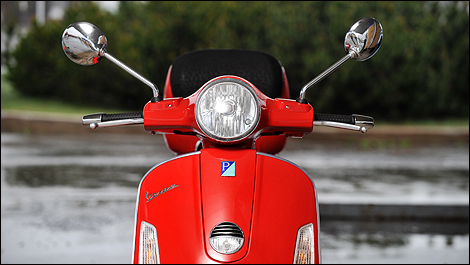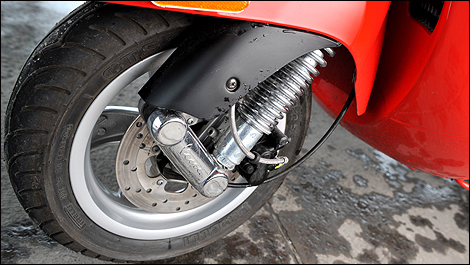Smitten by a wasp?*I finally picked up the first scooter lined up for my "Scoot to Work" project. My luck couldn't have been better! I'll be launching my project with none other than a
Vespa GTS 250ie, in Ferrari red to boot! As the first Vespa was manufactured by Piaggio in 1946 and the first Lambretta by Innocenti in 1947, I consider that Piaggio created the scooter concept - small-diameter wheel, engine mounted on the rocker arm under the seat, clear space between the seat and the steering column to enable the rider to get on it without having to mount it like a horse.
 |
| Except for the modern Piaggio logo, this is what a Vespa looked like 50 years ago, and what so many people are looking for today: classic Italian style! |
The first scooter used a very simple, two-stroke 50-cc engine and a three-speed manual transmission; changing gears was accomplished by rotating the left grip into one of three slots while squeezing the clutch lever located on the same side - a sort of squeeze-and-twist manoeuvre. The Vespa signature feature was and still is a single-arm suspension of "aeronautical" (As in Cessna or Piaggio) design up front.
And how does the red Vespa handle? Well! It was lent to me by Vespa Montréal, so I collected it downtown and jumped right into traffic. Acceleration is snappy and sufficient to keep my (over) 100 kilos ahead of the pack of cars. The front brake is solid and adjustable. The rear brake is very powerful, so much so that you need a little time to adapt your foot pressure and avoid rear wheel lock-up.
The suspension surprised me. Like all scooters, you get the impression that the bike pitches forward over large bumps, mostly from the fact that you are sitting high and near the front, so that changes in attitude of the front are felt more strongly than on a standard motorcycle. Although the rear shock absorber could benefit from a little more damping stiffness, the spring rate is about right. The suspension really stands out on small road irregularities, such as expansion joints, cracks, abrupt level changes, which it all absorbs with nary a protest. That may be because it's designed for the cobblestoned streets of traditional Italy. Naturally, Montreal's monstrous potholes quickly get the better of it, but even here, the bike remains stable and solid.
 |
| The Vespa signature single-sided front suspension, there from the beginning. |

